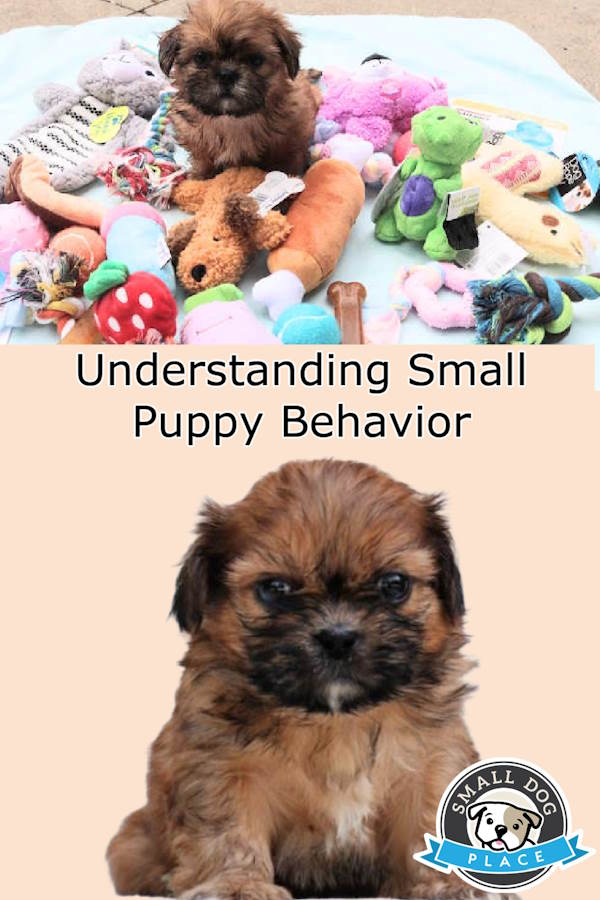- Small Dog Place Home
- Understanding Small Puppy Behavior
Understanding Small Puppy Behavior: Decode
the Language of Puppies
Understanding Small Puppy Behavior, by Janice Jones,
Last Updated 04-13-2024
Welcoming a new puppy into your home can be pure joy; however, stepping into the world of puppy-rearing can seemingly compare to solving an enigma. What's the secret behind those adorable head tilts, or why do their noses twitch incessantly?
Puppy behaviors, as whimsical and nostalgic as they may be, can bewilder even the most patient pet parents. Yet, don't worry as we journey into the silent language of our four-legged friends.
Together, we'll decode puppy communication, helping you to build an unbreakable bond with your playful pooch. So, please sit back, secure your reading glasses, and let's learn puppy parlance!
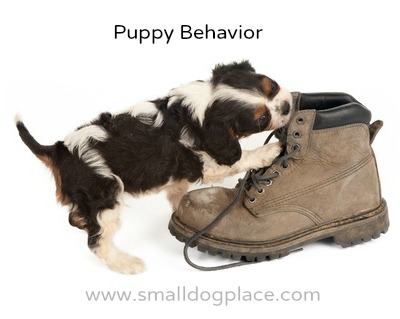 Understanding Small Puppy Behavior
Understanding Small Puppy BehaviorUnderstanding Small Puppy Behavior: Table of Contents
1. The Language of Small Puppies
2. Understanding Specific Behaviors
- Stressed Puppy Behavior
- Self-Calming Puppy Behaviors
- Curious Puppy Behavior
- Pre-elimination body language
- Excited Puppy Behavior
- Playful Puppy Behavior
- Respect for Elders (Canine Elders)
- Smelly Security Blanket
3. Dealing with Unwanted Behaviors
- List and brief explanations of several unwanted behaviors
4. Importance of Training
- Potty Training
- Leash Training
- Crate Training
- Basic Obedience Skills
5. Puppy Development and Age-Specific Behaviors
- Neonatal Period (0-2 weeks)
- Transitional period (2-4 weeks)
- Socialization period (4-12 weeks)
- Fear Imprint/Environmental Exploration period (8-11 weeks)
- Juvenile period (3-6 months)
- Adolescence (6-18 months)
6. Conclusion
7. About the Author
The Language of Small Puppies
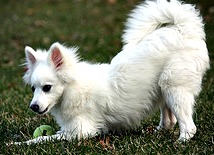 Play Bow: This puppy is ready to play
Play Bow: This puppy is ready to playPuppies and dogs do not share our sophisticated verbal language but have ways of communicating with us through their body.
They use a set of signals that can convey meaning to other dogs and to people if we learn how to interpret these signs. Dogs try to placate others with one set of signals, avoid confrontation with another group of behaviors and use yet another set of practices to calm themselves when stressed.
Many actions such as tail wagging can have more than one meaning, so focusing strictly on the body language may not give you the entire story.
Understanding Small Puppy Behaviors
Understanding a few important puppy behaviors will help you deal with and care for your new puppy
Stressed Puppy Behavior
Many young puppies leave the breeder or pet shop around the age of eight weeks. Unfortunately, eight weeks is the most popular time for puppies to leave the comfort and security of their mother and litter mates. At this age, they often develop and go through a fear stage.
Even confident dogs get stressed when placed in unfamiliar situations and will tell you how uncomfortable they are with various actions.
If you happen to be holding your puppy and you suddenly feel him tightening his grip on you, hugging, or clutching your arm tightly, you can be sure he is feeling stressed. He may also turn his head away from what is stressing him, preferring not to take a peak. He may also turn his head away yet keep an eye on the source of the stress, showing the whites of his eyes.
Shy puppies also habitually hold their tail between their legs rather than their usual position. If breed standards call for docked tails, you might not be able to notice this puppy behavior. A stressed or nervous dog may yawn to calm himself, a signal we may misinterpret because humans often yawn when fatigued.
Self-Calming Puppy Behaviors
Yawning is not the only method a puppy can use to calm himself. Your puppy might show other signs, such as sneezing, licking his nose, spinning, or shaking off the tension. If not cognizant of body language, many of these signs can go undetected, ignored, or misunderstood.
Some dogs might chase their tails to distract themselves from a perceived stressful event.
Examples of Self-calming puppy behaviors
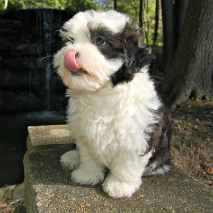 Licking lips Licking lips |
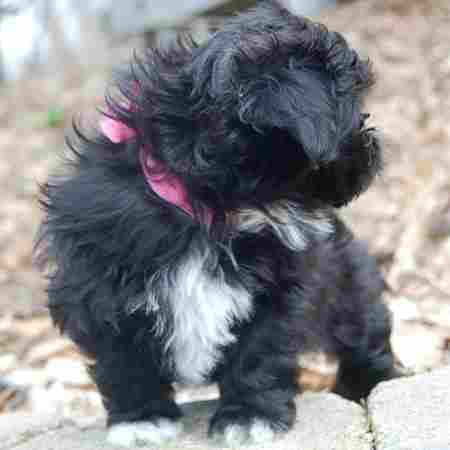 Turning away Turning away |
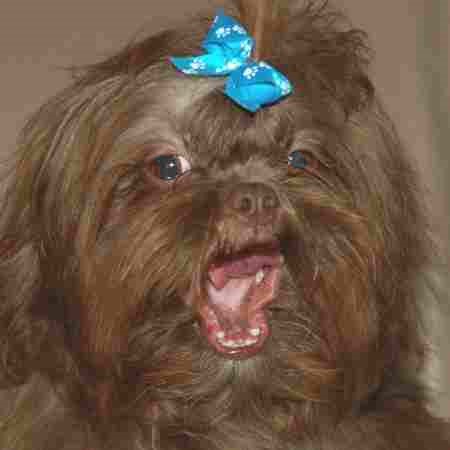 Yawning Yawning |
Feeling Curious
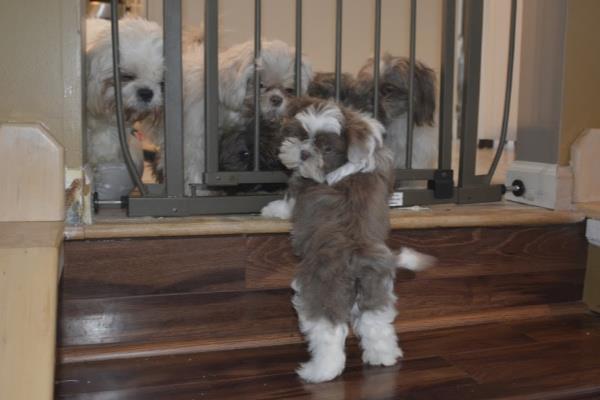
Curious puppies often show behaviors that humans find adorable.
Consider the little dog that tilts his head to one side or another. Something novel has caught his attention, and he is trying to make sense of it.
They are tilting their head because it puts an ear up and forward, helping them hear more clearly.
Dogs that lift one front paw are waiting for something to happen. She may be waiting for your signal to know what she should do next.
Feeling Like I Gotta Go
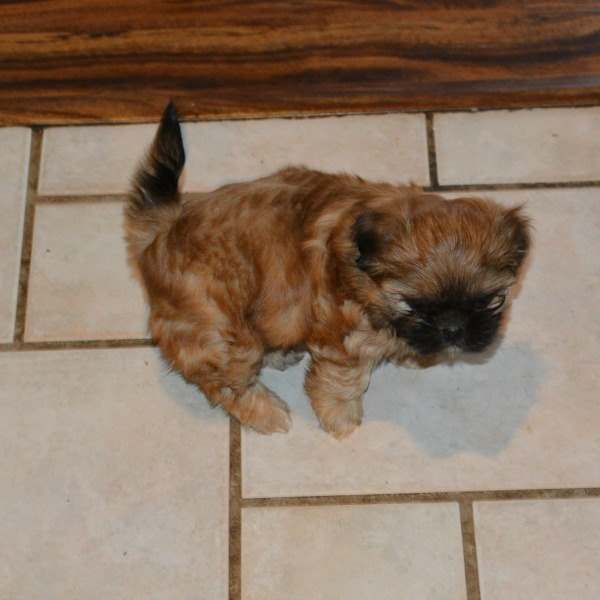
This is a tricky behavior, but one that all puppy parents need to learn if they want to potty train their pup. The telltale sign that your puppy is about to urinate or deficate is the sniffing the ground and walking in circles. Sometimes it's too late at this point to get the puppy to the potty spot.
If you can recognize the puppy's behaviors before the sniffing circling you have a better chance of housetraining success. A puppy who needs to go is going to start acting distracted and disinterested in what he was previously doing. He may move away from you or start walking in the opposite direction. If he had a toy in his mouth, he might drop it. That is the moment to respond to his behaviors by taking him to his potty spot.
Feeling Excited
Dogs show excitement in many ways. They may jump up, run in circles, bark, or yelp. Many will stop and roll over on their backs in anticipation of a belly rub.
Some dogs will urinate when excited, especially if they are so excited that they can’t hold it a second longer. This type of urination, known as submissive urination, has other meanings as well.
Feeling Playful
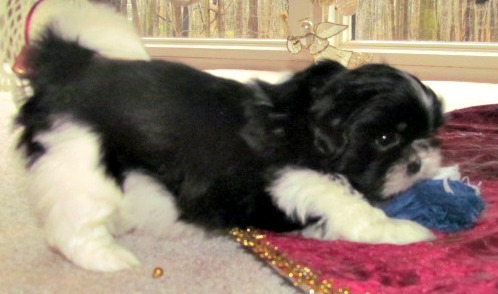 Playful Six-Week-Old-Puppy
Playful Six-Week-Old-PuppyYou will know your puppy wants to play when he looks relaxed, wagging his tail from side to side and blinking his eyes. A play bow, with his front legs flat on the ground and his back legs standing upright,, holding his rear end high, is an invitation to play.
This type of play bow is used with their owner and other dogs. Some dogs initiate play by rolling over on the back, inviting you to give them a belly rub. A small jump forward and freeze tells you they want to play now.
Playful Puppy Behavior
Puppies, just like human children, learn about their environment through exploration, experimentation, and play. One favorite puppy play game is fighting. This is always a very energetic game that often results in loud yelps, growls, and barks.
Puppies take turns nipping at each other, rolling around, jumping and climbing on each other, and having a great time. Their unsuspecting human might think there is an actual war going on between them. Very rarely does either puppy get hurt, but it does zap their energy, so many will immediately fall into a deep sleep.
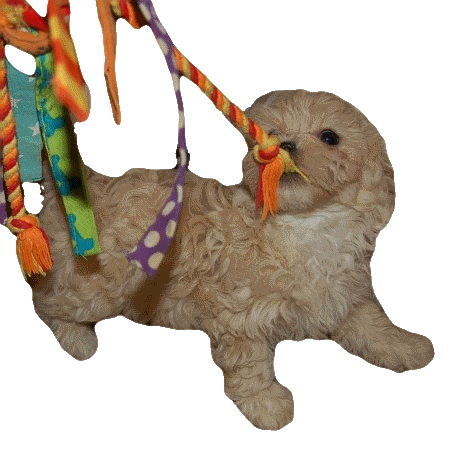 Tug of War Puppy Games
Tug of War Puppy GamesAnother favorite game of puppies is tug of war. Litter mates will find anything to use as a prop until they finally realize what works best.
This game is likely instinctual and a throwback from Wolves in the Wild. When wolves encountered a kill, they often had to use mouth and teeth strength to rip the food off the bones.
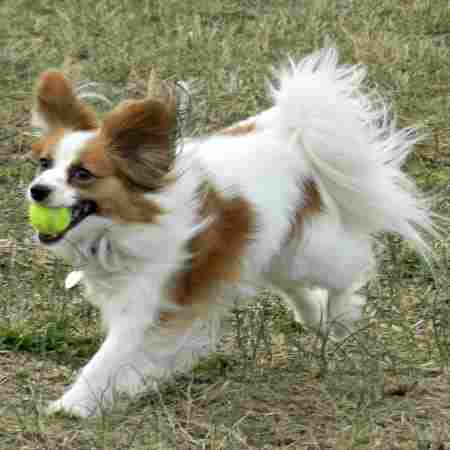 Playing Fetch
Playing Fetch Playing Fetch When a person decides to play with their puppy, a great game of fetch is probably the first thing that comes to mind.
Small dogs that love this game are those with the strongest prey drive, those bred to help with the hunt. Breeds bred solely as companion dogs are likely to find the game odd or just plain boring.
Playing nipping games with litter mates gradually teaches young puppies how tough they are. A few cries from littermates and bites from others make an impression on them.
Progressively, they will adjust their bite so no one gets hurt. Puppies taken away from siblings too early have a more challenging time learning to inhibit their bite, a puppy behavior that most humans prefer to avoid.
Respect for Elders (Canine Elders)
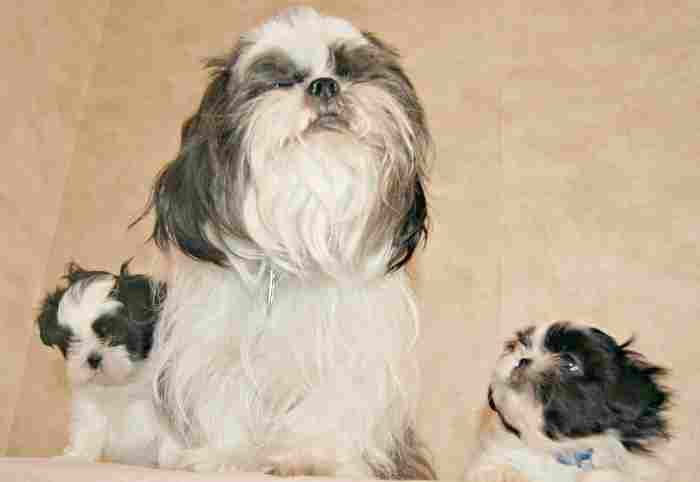 Learning to Respect older Dogs
Learning to Respect older DogsMany dogs learn from an early age that certain deferential puppy behaviors will win the hearts of an older or larger dog. Older, larger dogs usually appear to empathize with little puppies and typically show little aggression, probably because they see no threat in a tiny puppy.
Puppies learn from other dogs. They watch and imitate. This puppy behavior should be considered when a new dog is added to the family.
Puppies do have a way of endearing themselves to their elders. They will jump up towards the older dog’s face, licking and nuzzling at their face and mouth. Some puppies snuggle close to the older dog and roll over on their back as a sign of submission.
Smelly Security Blanket
All puppies (and adult dogs) like smelly things—the smellier, the better. This affinity for malodorous items usually comes as a surprise to many new puppy owners.
Have you ever wondered why some dogs love to sleep on their feet? It is unlikely they are looking for warmth. Instead, dogs love the smell of feet and anything associated with them—shoes, socks, and shoelaces.
Our feet have hundreds of thousands of sweat glands, which help produce enough smells to keep even the smallest of puppies interested.
So, the next time your dog snuggles on your feet, thank him for keeping you warm, but know his motive is far more self-serving than keeping your tootsies toasty.
Unwanted Puppy Behaviors
As a new puppy owner, it’s great to understand why puppies do what they do, but it’s not enough. There are plenty of behaviors I would rather not see or must deal with.
If your puppy is typical, there’s a good chance that you might also be seeing some of these issues. While not as cute as that tilted head or wagging tail, many of these concerns listed below are normal canine behaviors, but that doesn’t mean we must live with them forever.
Socializing your puppy continually and ongoing puppy training can help. I’ve also added links that will help you solve these issues.
List of Typical Unwanted Behaviors
- Excessive Barking: While barking is normal, too much can become a nuisance.
- Inappropriate Chewing: Chewing is a natural behavior for puppies but can become problematic when they chew on shoes, furniture, or other inappropriate objects.
- Jumping Up: Pupils may jump on people excitedly to get attention.
- Digging: Uncontrolled digging in the garden or home furniture can result in damage.
- Aggression: This might include snapping, growling, or biting.
- Elimination Inside the House: While potty training takes time, uncontrolled urination or pooping in the house is unwanted.
- Running Away or Not Coming When Called: Puppies may ignore the recall command, potentially endangering their safety.
- Whining or Crying: Continual whining can indicate discomfort, fear, separation anxiety, or desire for attention.
- Nipping and Biting: Puppies might bite during playing since they are still learning about bite inhibition.
- Food Guarding: This behavior is characterized by aggressive reactions when a puppy's food is approached.
- Pulling on the Leash: It becomes problematic on walks when a puppy pulls or tugs on the leash obsessively.
- Overexcitement: This results in uncontrollable behaviors, especially when visitors come to your home.
- Ignoring Commands: Puppies might ignore basic commands like "sit," "stay," or "down."
- Chasing: Puppies might excessively chase after people, other pets, cars, or their own tails.
Age-specific puppy behaviors do change over time.
Just like human development, dogs change over time. Some problems that seem insurmountable tend to resolve themselves even without intense training.
Some of the abovementioned concerns require training, such as not coming when called. Without some training, your dog may not achieve a reliable recall.
Luckily, some behaviors, such as excessive chewing, lessen with time. Once the puppy finishes the teething phase, you will notice a difference in unwanted chewing behavior.
Overexcitement is another example that changes with time. Naturally, breed-specific behaviors exist, but many small dogs calm down as they age.
Understanding Small Puppy Behavior: The Importance of Training
Training a puppy is integral to pet ownership, dramatically improving the dynamic between you and your furry friend. Training also provides an activity that you both share and can build that bond that is so important. Here's why the various elements of training are so important:
1. Potty Training:
This is one of the first and foremost aspects of dog training. It helps maintain cleanliness in your house and helps your puppy understand where it's appropriate to relieve themselves. The sooner a puppy understands this, the easier your life will be. This training starts the day the puppy arrives at your doorstep. Learn how to potty train your puppy.
2. Leash Training
Leash Training is crucial for safe, enjoyable walks and outdoor excursions. It ensures that your puppy behaves, doesn't pull you around, and, most importantly, prevents it from running into potentially dangerous situations. Finding a tiny collar or harness and a small leash for that tiny puppy can be challenging, but they make them in XXS.
3. Crate Training:
A well-adjusted, crate-trained puppy sees their crate as a haven. It aids potty training, can be a feeding location, and is invaluable when traveling. It provides your puppy with a familiar and safe space, reducing their anxiety and promoting a relaxing environment. Learn more about crate training.
4. Basic Obedience Skills:
Training your puppy with basic commands like 'sit,' 'stay,' 'come,' 'leave it,' etc., is essential for their safety. For instance, a well-learned 'leave it' command can prevent your dog from picking up potentially harmful substances. At the same time, an adequately taught 'stay' or 'come' can keep them away from dangerous situations. These commands also foster good manners in your puppy.
A well-trained dog is a happy, secure dog and a delight to be around. Learn about basic commands.
Puppy Development: Ages and Stages
As puppies grow and develop, they pass through various life stages, each characterized by distinct behavioral patterns. Understanding these age-specific behaviors can aid new puppy owners in tracking their pet's growth and cater to their evolving needs.
I thought it might help to take a quick look at puppy development and how puppies change from deaf and blind neonates to fully functioning adults in less than one year.
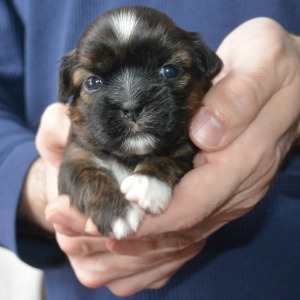 This is a 3 week old Shih Tzu puppy
This is a 3 week old Shih Tzu puppy1. Neonatal Period (0-2 weeks): During this phase, puppies mostly eat and sleep. They rely entirely on their mother as they cannot hear or see.
2. Transitional period (2-4 weeks): Puppies start opening their eyes and ears, and they begin to stand, crawl, walk, and even growl and wag their tails. They begin to interact with their siblings, albeit clumsily.
3. Socialization period (4-12 weeks): This stage is when your puppy starts becoming curious and exploring the world around them. They learn from their mother, siblings, other dogs, and humans. Good socialization experiences at this stage are prime for proper behavioral development.
4. Fear Imprint/Environmental Exploration period (8-11 weeks): Puppies explore their surroundings more, and during this stage, they exhibit fear toward objects or situations they perceive as threatening. Exposing the pup to a variety of experiences is vital during this stage.
5. Juvenile period (3-6 months): During this period, puppies typically look grown-up but act immature. They are excessively curious and active. They may test boundaries learned during training and begin teething, which increases chewing.
6. Adolescence (6-18 months): This phase sees the onset of sexual maturity, although the puppy is still mentally immature. Behaviors like marking, mounting, and roaming might increase. Obedience training, socialization, and patience will be paramount during this time.
Development in Small Dogs
This is just a brief introduction to puppy development stages that can be generalized to all canines. Small dogs develop faster and reach adulthood by 10 to 12 months, so the juvenile and adolescence stages are condensed.
Each stage presents unique challenges and joys and requires different care strategies. Training methods and approaches must be adjusted according to the puppy's maturity for the best outcomes.
Understanding these stages and behaviors gives you an insight into your puppy's mind, helping them grow into well-adjusted, sociable dogs.
Understanding Small Puppy Behavior: Last Words
Nurturing a puppy is a rewarding journey, and understanding their behavior is a pivotal part of this developmental voyage. Each wagging tail and head tilt has more to say than meets the eye.
Behind these adorable antics is a rich dog language that you can now decipher and appreciate. You embrace their delightful world by acknowledging their stress signals, validating their curiosity, welcoming their excitement and playfulness, and respecting their elder-adoration behavior.
Despite some challenges, such as exploring stinky shoes or unwanted chew toys, your path to understanding your puppy is laden with precious moments.
As you navigate puppy training and developmental stages, remember that patience, consistency, and kindness are your best allies.
Your journey with your puppy is more than just training. It is a beautiful dance of growth and bonding, a unique friendship that will flourish in the heart of understanding and patience.
As you embark on this journey, you're armed with the knowledge to comprehend their silent language, strengthen the bond, and cherish the moments with your furry companion.
Happy pet parenting!
Understanding Small Puppy Behavior: Pin for Future Reference
Understanding Small Puppy Development: More Resources
The Developmental Stages of Dogs
How to read your puppy's body language
About Janice (author and voice behind this site)
Janice Jones has lived with dogs and cats for most of her life and worked as a veterinary technician for over a decade. She has also been a small-breed dog breeder and rescue advocate and holds academic training in psychology, biology, nursing, and mental health counseling. Her work focuses on helping dog owners make informed, responsible decisions rooted in experience, education, and compassion.
When not writing, reading, or researching dog-related topics, she likes to spend time with her six Shih Tzu dogs, her husband, and her family, as well as knitting and crocheting. She is also the voice behind Miracle Shih Tzu and Smart-Knit-Crocheting
Does This Article Deserve Your Thumbs Up?
We always appreciate your support and encouragement. Your thumbs up means so much to us. Please like this article.
If you find this page or any page on Small Dog Place Helpful, or useful in anyway, I'd love it if you would click the small heart found on the bottom right of each page.
You can also share or bookmark this page -- just click on the:

Free Monthly Newsletter
Sign Up for Our Free Newsletter and get our Free Gift to You.
my E-book, The Top 10 Mistakes People Make When Choosing a Dog (and how to avoid them)
